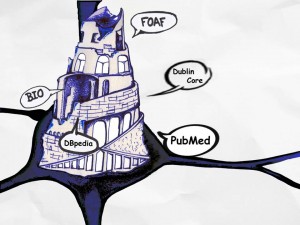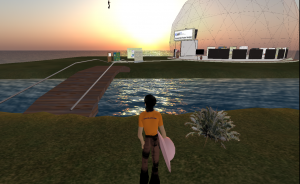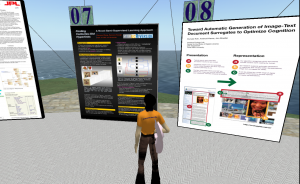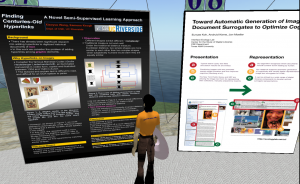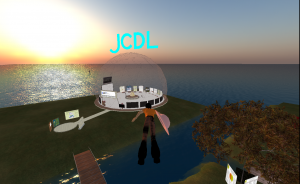Code4Lib2012 talk proposals are now on the wiki. This year there are 72 proposals for 20-25 slots. I pulled out the talks mentioning semantics (linked data, semantic web, microdata, RDF) for my own convenience (and maybe yours).
Property Graphs And TinkerPop Applications in Digital Libraries
- Brian Tingle, California Digital Library
TinkerPop is an open source software development group focusing on technologies in the graph database space.
This talk will provide a general introduction to the TinkerPop Graph Stack and the property graph model is uses. The introduction will include code examples and explanations of the property graph models used by the Social Networks in Archival Context project and show how the historical social graph is exposed as a JSON/REST API implemented by a TinkerPop rexster Kibble that contains the application’s graph theory logic. Other graph database applications possible with TinkerPop such as RDF support, and citation analysis will also be discussed.
HTML5 Microdata and Schema.org
- Jason Ronallo, North Carolina State University Libraries
When the big search engines announced support for HTML5 microdata and the schema.org vocabularies, the balance of power for semantic markup in HTML shifted.
- What is microdata?
- Where does microdata fit with regards to other approaches like RDFa and microformats?
- Where do libraries stand in the worldview of Schema.org and what can they do about it?
- How can implementing microdata and schema.org optimize your sites for search engines?
- What tools are available?
“Linked-Data-Ready” Software for Libraries
- Jennifer Bowen, University of Rochester River Campus Libraries
Linked data is poised to replace MARC as the basis for the new library bibliographic framework. For libraries to benefit from linked data, they must learn about it, experiment with it, demonstrate its usefulness, and take a leadership role in its deployment.
The eXtensible Catalog Organization (XCO) offers open-source software for libraries that is “linked-data-ready.” XC software prepares MARC and Dublin Core metadata for exposure to the semantic web, incorporating FRBR Group 1 entities and registered vocabularies for RDA elements and roles. This presentation will include a software demonstration, proposed software architecture for creation and management of linked data, a vision for how libraries can migrate from MARC to linked data, and an update on XCO progress toward linked data goals.
Your Catalog in Linked Data
- Tom Johnson, Oregon State University Libraries
Linked Library Data activity over the last year has seen bibliographic data sets and vocabularies proliferating from traditional library
sources. We’ve reached a point where regular libraries don’t have to go it alone to be on the Semantic Web. There is a quickly growing pool of things we can actually ”link to”, and everyone’s existing data can be immediately enriched by participating.
This is a quick and dirty road to getting your catalog onto the Linked Data web. The talk will take you from start to finish, using Free Software tools to establish a namespace, put up a SPARQL endpoint, make a simple data model, convert MARC records to RDF, and link the results to major existing data sets (skipping conveniently over pesky processing time). A small amount of “why linked data?” content will be covered, but the primary goal is to leave you able to reproduce the process and start linking your catalog into the web of data. Appropriate documentation will be on the web.
NoSQL Bibliographic Records: Implementing a Native FRBR Datastore with Redis
- Jeremy Nelson, Colorado College, jeremy.nelson@coloradocollege.edu
In October, the Library of Congress issued a news release, “A Bibliographic Framework for the Digital Age” outlining a list of requirements for a New Bibliographic Framework Environment. Responding to this challenge, this talk will demonstrate a Redis (http://redis.io) FRBR datastore proof-of-concept that, with a lightweight python-based interface, can meet these requirements.
Because FRBR is an Entity-Relationship model; it is easily implemented as key-value within the primitive data structures provided by Redis. Redis’ flexibility makes it easy to associate arbitrary metadata and vocabularies, like MARC, METS, VRA or MODS, with FRBR entities and inter-operate with legacy and emerging standards and practices like RDA Vocabularies and LinkedData.
ALL TEH METADATAS! or How we use RDF to keep all of the digital object metadata formats thrown at us.
- Declan Fleming, University of California, San Diego
What’s the right metadata standard to use for a digital repository? There isn’t just one standard that fits documents, videos, newspapers, audio files, local data, etc. And there is no standard to rule them all. So what do you do? At UC San Diego Libraries, we went down a conceptual level and attempted to hold every piece of metadata and give each holding place some context, hopefully in a common namespace. RDF has proven to be the ideal solution, and allows us to work with MODS, PREMIS, MIX, and just about anything else we’ve tried. It also opens up the potential for data re-use and authority control as other metadata owners start thinking about and expressing their data in the same way. I’ll talk about our workflow which takes metadata from a stew of various sources (CSV dumps, spreadsheet data of varying richness, MARC data, and MODS data), normalizes them into METS by our Metadata Specialists who create an assembly plan, and then ingests them into our digital asset management system. The result is a HTML, RSS, METS, XML, and opens linked data possibilities that we are just starting to explore.
UDFR: Building a Registry using Open-Source Semantic Software
- Stephen Abrams, Associate Director, UC3, California Digital Library
- Lisa Dawn Colvin, UDFR Project Manager, California Digital Library
Fundamental to effective long-term preservation analysis, planning, and intervention is the deep understanding of the diverse digital formats used to represent content. The Unified Digital Format Registry project (UDFR, https://bitbucket.org/udfr/main/wiki/Home) will provide an open source platform for an online, semantically-enabled registry of significant format representation information.
We will give an introduction to the UDFR tool and its use within a preservation process.
We will also discuss our experiences of integrating disparate data sources and models into RDF: describing our iterative data modeling process and decisions around integrating vocabularies, data sources and provenance representation.
Finally, we will share how we extended an existing open-source semantic wiki tool, OntoWiki, to create the registry.
saveMLAK: How Librarians, Curators, Archivists and Library Engineers Work Together with Semantic MediaWiki after the Great Earthquake of Japan
- Yuka Egusa, Senior Researcher of National Institute of Educational Policy Research
- Makoto Okamoto, Chief Editor of Academic Resource Guide (ARG)
In March 11th 2011, the biggest earthquake and tsunami in the history attacked a large area of northern east region of Japan. A lot of people have worked together to save people in the area. For library community, a wiki named “savelibrary” was launched for sharing information on damages and rescues on the next day of the earthquake. Later then people from museum curators, archivists and community learning centers started similar projects. In April we joined to a project “saveMLAK”, and launched a wiki site using Semantic MediaWiki under http://savemlak.jp/.
As of November 2011, information on over 13,000 cultural organizations are posted on the site by 269 contributors since the launch. The gathered information are organized along with Wiki categories of each type of facilities such library, museum, school, etc. We have held eight edit-a-thons to encourage people to contribute to the wiki.
We will report our activity, how the libraries and museums were damaged and have been recovered with lots of efforts, and how we can do a new style of collaboration with MLAK community, Wiki and other voluntary communities at the crisis.
Conversion by Wikibox, tweaked in Textwrangler. Trimmed email addresses, otherwise these are as-written. Did I miss one? Let me know!
